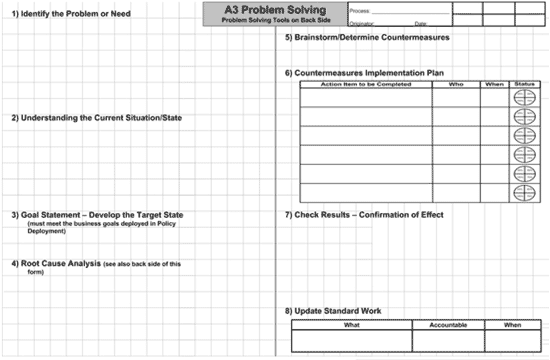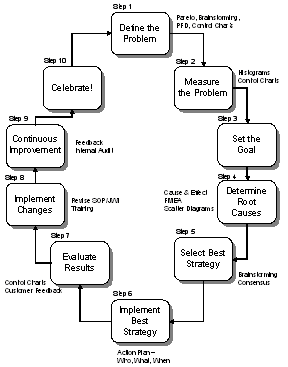A problem-solving style can be described using dimensions of assertiveness and cooperation. If distance is measured in kilometers and time is measured in hours the rate would have the dimensions.

A3 Problem Solving What It Is And What It Isn T
Alternatives should be evaluated using a consistent process.

. Importantly these dimensions define a space for other coping categories. Structure and consideration b. Question 47 2 points A problem-solving style can be described using dimensions of Question 47 options.
Using this style you identify the problem that has occurred explore alternatives in solving the problem and develop a plan. You can treat dimensions as variables. Involves the exploration of the problem and the effects of your environment.
Information sharing is an important feature of this style because both parties need to identify common ground and potential solutions that satisfy both or all of them. Experts say there are different kinds of problem-solving styles. Identical units can divide out or cancel.
You can generate alternatives through brainstorming surveys discussion groups or other means. Dominance and sociability d. A problem solving style can be described using the dimensions of.
Allport 1950 for example describes a mature religion in part as active. Look a little closer and life is just one of those big problems full of little unavoidable problems. To problem solving and decision making since they are associated with fundamental differences in orientation to problem solving and goals to be addressed.
Understanding this research can help you apply the lessons the police profession has learned over the last third of a centuryThere has been considerable research into which police practices are effective at reducing. Helpful problem-solving techniques include using flowcharts to identify the expected steps of a process and cause-and-effect diagrams to define and analyze root causes. This formula can be rewritten for rate.
Orientation to Change People with a well-defined Explorer preference tend to seek novelty and generate many original options. In a crisis exploring alternatives involves. Problem solving consists of using generic or ad hoc methods in an orderly manner to find solutions to difficulties.
A problem-solving style can be described using dimensions of A structure and consideration. Consider the distance formula. Some of the problem-solving techniques developed and used in philosophy medicine societies mathematics engineering computer science and artificial intelligence in general are related to mental problem-solving techniques studied in psychology.
Because several personality and affectivity dimensions are significantly related some of the low albeit significant correlations with the problem-solving dimensions in Table 1 may be basically spurious reflecting the indirect influences of stronger correlated predictor variables. Solving problems by converting dimensions or canceling dimensions is the focus of this lesson. Verywell Joshua Seong.
A problem-solving style can be described using dimensions of keep your cool and ask the bully to fully explain what he or she is trying to say or do. Problems seem like something to avoid. Researchers have identified four types of parenting styles.
Each style takes a different approach to raising children and can be identified by a number of different characteristics. Consider the future and think about all of the things that can get in the way of solving the problem you are. These dimensions can also be used to assess and describe various learning styles.
The problem-solving process requires implementing a certain strategy which may lead the problem solver to explore multiple ideas by developing and testing hypotheses. Logical thinking problem solving style. Positive emotional coping efficiency problem solving preoccupation with the problem negative emotional coping helplessness problem avoidance and hedonic disengagement.
Problem solving tries to find a mutually beneficial solution for both parties. Know what is effective and not in policingEvidence on what makes police effective points to the vital role of crime analysis in 21st century policing. Structure and cooperation c.
While each dimension represents a unique aspect of a learning style individual learning style may include a combination of these dimensions. For example your learning style might include elements of extraverted sensing feeling and perceiving learning styles. The two dimensions underlying the styles of problem-solving locus of responsibility.
B structure and cooperation. The sections below help explain key problem-solving steps. But in reality they are unavoidable.
The first dimension considered in temperament is the one related to differences in the perceptual processes used in gathering information--the S-N dimension. And level of activity have been used to distinguish people holding different religious. An Assessment of Problem Solving StyleSM has three dimensions Orientation to Change Manner of Processing and Ways of Deciding.
A problem solving style can be described using. When dealing with a bully the best strategy is to. Diagnose the situation so that your focus is on the problem not just its symptoms.
Hence in order to determine what personality or affectivity dimensions are the most. Students can develop new knowledge solve problems that occur apply and use various strategies and also reflect and monitor the problem-solving process. C dominance and sociability.
Question 6 A n accommodating style is an appropriate conflict management style when resolving the conflict is not worth the potential damage to the relationship. The model contains a total of eight coping styles forming a circumplex.

Problem Solving Model Bpi Consulting

0 Comments